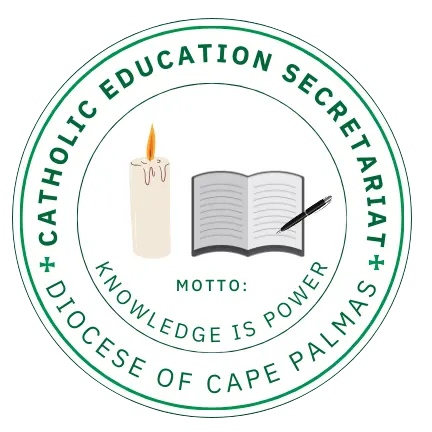A Brief History of Catholic Education in Liberia: Credit to President Hilary Richard Wright Johnson
By Sr. Philomena Wrehdi Jappah, SHF – June 27, 2025
Hilary Richard Wright Johnson, the 11th President of Liberia, holds a distinguished place in both the political and religious history of the nation. Serving from 1884 to 1892, Johnson was the first Liberian-born and first African-born Black man to become president of a republic. His presidency was marked by a deep commitment to national sovereignty, educational advancement, and a remarkable openness to inter-religious collaboration that would significantly shape the future of Liberia’s religious and educational landscape.
Early Catholic Missionary Attempts in Liberia
Before Johnson’s time, the Catholic Church had made several early but unsuccessful attempts to establish a lasting presence in Liberia. The first documented effort was in 1841, when Fr. Edward Barron and Fr. Kelly, under the jurisdiction of the Vicariate Apostolic of the Two Guineas, arrived from the United States. They faced extreme conditions, including high mortality from tropical diseases. By 1845, most of the missionaries had died or returned home, and the mission collapsed. A second effort was made in the mid-19th century, but it too failed due to logistical difficulties, poor health, and a lack of institutional support. These repeated setbacks left Liberia without a stable Catholic presence for decades.
A Bold Appeal to the Holy See
Understanding both the moral and educational potential of the Catholic Church, President Johnson made a formal appeal to the Holy See (Vatican) between 1884 and 1885, requesting the re-establishment of Catholic missions and schools in Liberia. At the time, the country had no active Catholic presence, and Johnson’s appeal was both spiritual and strategic—aimed at enriching Liberia’s religious life and enhancing educational opportunities for its citizens. His request was a bold act of statesmanship, especially given the previous failures and his own non-Catholic background.
The Vatican’s Response and the Return of the Mission
In 1886, Pope Leo XIII responded favorably to Johnson’s appeal by appointing Fr. Jean Ogé, a member of the Society of African Missions (SMA), as Apostolic Prefect of Liberia. That same year, Fr. Ogé and his fellow SMA missionaries arrived in Monrovia, officially reviving the Catholic Church’s presence in the country. With the establishment of the Apostolic Prefecture of Liberia, the missionaries began opening schools, chapels, and pastoral ministries. Their efforts centered on evangelization, education, and social development, laying the foundation for a lasting and fruitful relationship between the Catholic Church and the Liberian state.
Establishing a Network of Catholic Schools
The SMA missionaries wasted no time in their educational mission. They established schools that aimed to reduce illiteracy, promote Christian values, and support civic formation. The curriculum emphasized reading, writing, arithmetic, and catechism, creating a model rooted in discipline and moral development. These schools were open to all Liberians, regardless of religion or background, and quickly became known for their academic rigor, inclusivity, and community service.
The Church’s educational reach expanded over time beyond Monrovia to areas such as Grand Bassa, Maryland (Harper), and today across the country,In the decades that followed, various religious congregations, male and female, joined the mission, contributing to the growth of Catholic education throughout the country.
Catholic Education and National Development
In Liberia, as in many countries, the Catholic Church has long played a dual role: spreading the Gospel and partnering with the government in the national development agenda, particularly through education. In the early 1950s, the church intensified its commitment by establishing schools in response to widespread illiteracy and a shortage of trained teachers.One of the most significant developments during this period was the founding of Fatima College in Cape Palmas in 1952—a Catholic Teacher Training Institution established to prepare educators for Catholic and public schools across the country. This initiative represented a natural extension of Johnson’s vision for building a well-educated citizenry grounded in moral values and civic responsibility.
A Lasting Legacy
President Hilary R. W. Johnson’s appeal to the Vatican remains a milestone in Liberia’s diplomatic and religious history. It marked the first formal request by a Liberian head of state to the Holy See, reintroducing Catholicism to the country and laying the groundwork for an enduring Church-state partnership. His vision exemplified religious tolerance, strategic leadership, and a deep understanding of the transformative power of education.
Conclusion
Today,with the existence of 68 Catholic schools,Catholic schools are among the most respected educational institutions in Liberia. Serving over 20,000 students and continuing to shape leaders in all sectors of society. Many of Liberia’s religious, civic, and educational leaders trace their formation to these institutions, testifying to President Johnson’s remarkable foresight and enduring influence.
A portion of this article is an excerpt from:
Fisher, H. P. (1929).The Catholic Church in Liberia.Records of the American Catholic Historical Society of Philadelphia, 40(3), 249–310. American Catholic Historical Society.
Cengage Learning. (2021).Education in Liberia: Historical and Contemporary Perspectives.
